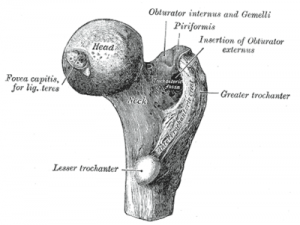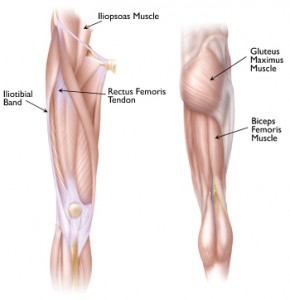In the world of CoreWalking treatment for snapping hip syndrome is purely a movement issue.
If you walk correctly your hip can stop snapping.
Snapping hip syndrome strikes me as nothing more than a misaligned body moving in all the wrong ways.
 On the inside and the outside of the leg, or femur bone, we find two small bony knobs to which muscles attach.
On the inside and the outside of the leg, or femur bone, we find two small bony knobs to which muscles attach.
The lesser trochanter is on the inside of the leg and is the attachment point for the iliopsoas muscle.
It is called the iliopsoas because the psoas major and iliacus meet to form a common tendon.
The greater trochanter is home to a number of muscles. These include gluteus medius and minimus, the piriformis, the obturator muscles, and the gemelli muscles.
It is important that one muscle attaches to the lesser trochanter, and a whole host of muscles connect to the greater trochanter. But that is the subject of another post.
Snapping hip syndrome is usually the IT band or gluteus maximus tendon snapping over and around the greater trochanter, or the iliopsoas snapping around the lesser trochanter.
In general, there isn’t much by way of treatment for snapping hip syndrome.
It often occurs without accompanying pain so people are usually told to not worry about it too much.
Those who do suffer pain from a snapping hip aren’t really presented much by way of help either.
The RICE protocol– rest, ice, elevate, compression– is the most common treatment offered. This doesn’t appeal to me much.
Treatment in physical therapy usually includes stretches in hopes of creating longer muscles that will stop snapping around the trochanters.
Sometimes cortisone injections are given and occasionally a surgical option is explored.
One thing you don’t see very much is the suggestion that if you walk differently your hip will stop snapping.
But I have worked with more than a few sufferers of snapping hip syndrome and I am here to tell you that walking correctly is the easiest and best treatment available.
Why Walking Is The Best Treatment For Snapping Hip Syndrome
To repeat myself for the 900th time, I think everybody leans backward and walks with a misaligned pelvis.
This is a very simple formula for creating snapping hip syndrome.
I teach people to walk by taking the thighs back under the hips and leading from the core instead of the legs.
When the legs lead the way the possibilities for snapping the hip increase exponentially.
This is because the iliopsoas is pulled forward and the IT Band is pulled backward in exactly the way they shouldn’t be moving.
When we move successfully from the core and the psoas, the ball, or head, of the femur bone is properly twisted into the hip sockets and there is no reason why any snapping will occur.
In general, I think most people are standing and walking with feet and legs turned out.
This turnout, however slight, can misalign the femur heads, and trochanters, leading to that snapping sound and feeling.
I know it is redundant but walking correctly is the answer for so much of what ails us.

